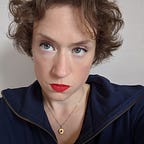The Havoc of Exile
Review of The Cult in My Grandmother’s House
Anna Sandermoen uses a mix of vivid childs-eye detail and dispassionate adult reflection to tell this wild ride of childhood in a cult, a warning of what happens when passive collusion lets powerful men run away with power.
The late Soviet Union gave a perfect storm of circumstances: a society that denigrated the individual, a tradition of following charismatic authority figures, pervasive mistrust of the official institutions from government to medicine, and an educated population drawn to science and psychology. These conditions allowed Anna’s grandmother to get sucked in and to persuade her daughter to give the child Anna over for seven years of abuse and neglect.
These raw memoirs are shocking and at times hard to read, but the profanity and abuse is necessary to show how the adults let down the children in their care. But neither is it all doom and gloom. There are beautiful details and descriptions of scenes the average western reader has literally never imagined.
This local colour was what I enjoyed most. Rousing patriotic ceremonies, working on rat-infested farms, hitchhiking through central Asian truckstops, burning dung on dried-up seas. The conditions of poverty are leavened with deadpan humour.
In my experience there is a noticeable dearth of engaging, authentic voices from the post-Soviet space. The publishing world has its ‘poverty lit’ and stories of oppressed women in exotic Asian or African countries, from Memoirs of a Geisha to numerous tales from China or Pakistan. But typical stories from the former USSR focus on the experience of expats in Moscow, and their stories are rife with tropes of glamorous blond devushkas, spies, vodka, pictures of Stalin on the wall and many other stereotypes. This book shows a different side.
Experience is rich and ambiguous so despite the poverty there is recognisable pride in aspects of Soviet life like its operas or its frontier-style natural resource culture, its dinosaur bones. Through Anna’s eyes we share the pride of going on a geological expedition or being sworn into a youth organisation.
The cult’s methods are all the more chilling because they are built on a kernel of real science. The right and left hemispheres of the brain do correspond to opposite sides of the body. Some of the tests to discern and mimic complex patterns seem plausibly similar to accepted tests such as the Wechsler Intelligence Scale for Children, which are used to benchmark development and are totally benign. Anna’s confused eagerness not to let down the adult running the tests shows the demand effect, when the subject responds what the researcher wants to hear.
The ensuing abuse and total neglect is all the more disturbing because it started with respected academics. These details give generalisability: it sits beside the Stanford prison experiment, Neubauer twin experiment and other tales of misguided ethical nightmares in the guise of psychology. They also lend the story poignancy: we feel horror that such an educated lady as Anna’s grandma could be taken in by nonsense, but we also feel compassion, because we see how the social isolation of exile can wreak havoc on an educated, prehensile mind. Anna’s grandma needed stimulation and an outlet for her intellectual and creative energies, and fell in with the wrong crowd. Ultimately she bears responsibility but it’s the common enough tragedy of every person throughout art and history who chose the wrong cause to believe in and sacrificed their own kin.
In a one-dimensional fictional world, an underground group who resisted the Soviet mainstream might be heroes. It’s easy to imagine a tale of plucky scientists building up the individual to counter the prevailing dehumanisation in society. That is not what happens here. The cult in these pages fell between two stools and created the worst of all worlds: they keep their biases and blinkers, while depriving the children of the warmth of society and family.
I haven’t even mentioned the book’s main function as an expose of a powerful man and of his cult which continues to operate with impunity today. I haven’t set either him or his cult in context of similar instances in other countries. I keep hoping an investigative journalist will pick it up. In any case it’s a project for another time. In the meantime, read it and let me know what you think!
Full disclosure: I’m the translator of the English edition of this book but these views are my own. I know the author so I know that every word of this book is true. That she has attained such wisdom, compassion and success in her life is testament to her resilience and spirit. Her insight shines out of this book to illuminate important issues around family and society. Read it and you might get closer to healing your own wounds too.
